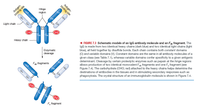
Biochemistry
9th Edition
ISBN: 9781319114671
Author: Lubert Stryer, Jeremy M. Berg, John L. Tymoczko, Gregory J. Gatto Jr.
Publisher: W. H. Freeman
expand_more
expand_more
format_list_bulleted
Concept explainers
Question
What physiological effect would you predict from a mutation that replaced
with serine the cysteine in the constant part of the immunoglobulin light
chain that is involved in disulfide-bond formation with the heavy chain?
(as shown)

Transcribed Image Text:binding site
Antigen-
binding site
VH
Hlnge
reglon
S-S
Light chaln
CHO
CH
CHO
CH
1 FIGURE 7.3 Schematic models of an IgG antibody molecule and an Fab fragment. The
IgG is made from two identical heavy chains (dark blue) and two identical light chains (light
blue), all held together by disulfide bonds. Each chain contains both constant domains
(C) and variable domains (V). Constant domains are the same in all antibody molecules of a
given class (see Table 7.1), whereas variable domains confer specificity to a given antigenic
determinant. Cleavage by certain proteolytic enzymes such as papain at the hinge regions
allows production of two identical monovalent Fab fragments and one F, fragment (see
Figure 7.4). The carbohydrate (CHO; red) attached to the heavy chains helps determine the
destinations of antibodies in the tissues and in stimulating secondary responses such as
phagocytosis. The crystal structure of an immunoglobulin molecule is shown in Figure 7.4.
Heavy chaln
Enzymatlc
dleavage
Fab fragments
VH
VL
S-S
ss
CHO
CH CH
CHO
Fe fragment
Antigen-
Expert Solution
This question has been solved!
Explore an expertly crafted, step-by-step solution for a thorough understanding of key concepts.
This is a popular solution
Trending nowThis is a popular solution!
Step by stepSolved in 3 steps

Knowledge Booster
Learn more about
Need a deep-dive on the concept behind this application? Look no further. Learn more about this topic, biochemistry and related others by exploring similar questions and additional content below.Similar questions
- Nearly all immune deficiency diseases that result in impaired TH17 and ILC3 function lead to chronic mucocutaneous candidiasis (CMC), usually accompanied by increased susceptibility to pyogenic bacterial infections. However, a subset of these patients also show increased susceptibility to intracellular bacterial infections, such as those caused by Mycobacteria species. What is the explanation for why some, but not all, of these patients have increased susceptibility to intracellular bacteria and which patients fall into this category?arrow_forwardWhat is the mechanism of the Contactin-BIG-1arrow_forwardYou have synthesized an oligopeptide containing an RGD motif surrounded by other amino acids. What is the effect of this peptide when added to a fibroblast cell culture grown on a layer of fibronectin adsorbed to the tissue culture dish? Why does this happen?arrow_forward
- Normal Hgb is referred to as HbA and contains 4 subunits, 2 a-globin chains and 2 B-globin chains, arranged as two dimers of aß. In Sickle Cell Disease, both B-globin chains are altered in the dimers (aßS/aßS). Q3: Which level of structure does the aß/aß and aßS/aßS in HbA and HbS describe?arrow_forwardWhat amino acids can be found in chymotrypsin’s specificity pocket? What would happen if one of those amino acids was changed to lysine? In relation to the amino acid in the specificity pocket, which peptide bond is cleaved; C terminal or N terminal? What is this bond’s proximity to the serine in the active site?arrow_forwardThe mutation in hemoglobin at B82 Lys → Asp results in lowered O,-binding affinity compared to normal hemoglobin. B82 is one of the residues that lines the 2,3-BPG binding site (see Figure 7.29; B82 is adjacent to His143). Based on the location of this residue and the differences between Lys and Asp, sug- gest a rationale for the observed reduction in Oz-binding affinity.arrow_forward
arrow_back_ios
arrow_forward_ios
Recommended textbooks for you
 BiochemistryBiochemistryISBN:9781319114671Author:Lubert Stryer, Jeremy M. Berg, John L. Tymoczko, Gregory J. Gatto Jr.Publisher:W. H. Freeman
BiochemistryBiochemistryISBN:9781319114671Author:Lubert Stryer, Jeremy M. Berg, John L. Tymoczko, Gregory J. Gatto Jr.Publisher:W. H. Freeman Lehninger Principles of BiochemistryBiochemistryISBN:9781464126116Author:David L. Nelson, Michael M. CoxPublisher:W. H. Freeman
Lehninger Principles of BiochemistryBiochemistryISBN:9781464126116Author:David L. Nelson, Michael M. CoxPublisher:W. H. Freeman Fundamentals of Biochemistry: Life at the Molecul...BiochemistryISBN:9781118918401Author:Donald Voet, Judith G. Voet, Charlotte W. PrattPublisher:WILEY
Fundamentals of Biochemistry: Life at the Molecul...BiochemistryISBN:9781118918401Author:Donald Voet, Judith G. Voet, Charlotte W. PrattPublisher:WILEY BiochemistryBiochemistryISBN:9781305961135Author:Mary K. Campbell, Shawn O. Farrell, Owen M. McDougalPublisher:Cengage Learning
BiochemistryBiochemistryISBN:9781305961135Author:Mary K. Campbell, Shawn O. Farrell, Owen M. McDougalPublisher:Cengage Learning BiochemistryBiochemistryISBN:9781305577206Author:Reginald H. Garrett, Charles M. GrishamPublisher:Cengage Learning
BiochemistryBiochemistryISBN:9781305577206Author:Reginald H. Garrett, Charles M. GrishamPublisher:Cengage Learning Fundamentals of General, Organic, and Biological ...BiochemistryISBN:9780134015187Author:John E. McMurry, David S. Ballantine, Carl A. Hoeger, Virginia E. PetersonPublisher:PEARSON
Fundamentals of General, Organic, and Biological ...BiochemistryISBN:9780134015187Author:John E. McMurry, David S. Ballantine, Carl A. Hoeger, Virginia E. PetersonPublisher:PEARSON

Biochemistry
Biochemistry
ISBN:9781319114671
Author:Lubert Stryer, Jeremy M. Berg, John L. Tymoczko, Gregory J. Gatto Jr.
Publisher:W. H. Freeman

Lehninger Principles of Biochemistry
Biochemistry
ISBN:9781464126116
Author:David L. Nelson, Michael M. Cox
Publisher:W. H. Freeman

Fundamentals of Biochemistry: Life at the Molecul...
Biochemistry
ISBN:9781118918401
Author:Donald Voet, Judith G. Voet, Charlotte W. Pratt
Publisher:WILEY

Biochemistry
Biochemistry
ISBN:9781305961135
Author:Mary K. Campbell, Shawn O. Farrell, Owen M. McDougal
Publisher:Cengage Learning

Biochemistry
Biochemistry
ISBN:9781305577206
Author:Reginald H. Garrett, Charles M. Grisham
Publisher:Cengage Learning

Fundamentals of General, Organic, and Biological ...
Biochemistry
ISBN:9780134015187
Author:John E. McMurry, David S. Ballantine, Carl A. Hoeger, Virginia E. Peterson
Publisher:PEARSON